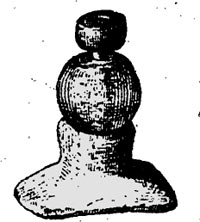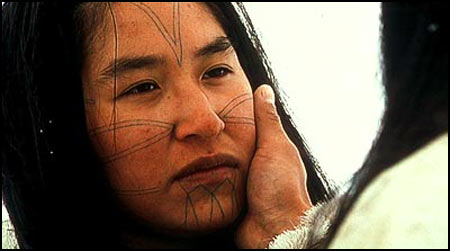Eskimo
Inuit are a people who live near the Arctic. Their homeland stretches from the northeastern tip of Russia across Alaska and northern Canada to parts of Greenland. Inuit refers to the people formerly called Eskimos. The term Eskimo comes from a derogatory Native American word that may have meant 'eater of raw meat'. The name Inuit, which means 'the people' or 'real people' and comes from a language called Inuit-Inupiaq, is currently the preferred term. The singular of Inuit is Inuk, which means 'person'.
Many high ranking women in Inuit and Tlingit tribes wore large labrets called a tootuk or just tutu (generally speaking, the larger the labret, the higher the rank of the family) — these are also often seen symbolically in artwork. Pierced nose jewelry was also worn. In addition, many of the people of the north wore tattoos including facial tattoos (the word for tattoo in their language is tab la o'tit). Men also wore these modifications depending on the region.
To quote from an 1890 English-Eskimo dictionary (by John W. Kelly and Roger Wells[1]), which comments on one of many northern region's ornamentation,
- ORNAMENTATION
- At any time from sixteen to twenty-two years of age the male natives have their lower lips pierced [under] each corner of their mouth for labrets. When the incision is first made, sharp-pointed pieces of ivory are put in. After the wound heals the hole is gradually stretched to half an inch in diameter. Some of the poorer natives wear labrets made from cannel coal, ivory, common gravel, and glass stoppers obtained from ships, which they shape for the purpose. All who can obtain them have agate ones. One labret is almost always plain, and shaped like a plug hat, with the rim inside the mouth to hold it in; the other has a white washer an inch and a half in diameter just outside the lip, held in place by a nut of turquoise fastened to the end of the labret by petroleum pitch from Icy Reef or spruce gum from the Nooatok. It is not known where they have obtained the turquoise or the porcelain-like washer. The natives say they have always been in the country, and have been handed down by successive generations. Some of the old men who have made a good record as whalemen tattoo their cheeks; some of the designs are triangular, an inch long, with one point intersecting the corner of the mouth. Another kind is a rectangular bar an inch and a half long, extending from the corners of the mouth toward the ears.
- Some of the girls have their ears pierced just back of the lobe, where it is thinnest. They wear ivory ear-rings, some of which are carved with plain figures, while others have a setting of turquoise. Some of them have a string of beads extending from one ear-ring to the other, suspended under the throat. There are rare instances where the Cape Prince of Wales girls wear turquoise suspended to the cartilage of the nose between the nostrils. Tattooing the chin among the women is general, and it is kept up, so they say, because it has always been the custom. At the age of six, one narrow perpendicular line is drawn down the centre of the chin, powdered charcoal being used in coloring. At about twelve years of age the line is broadened to half of an inch, and a narrow line drawn parallel to it on each side. Sometimes the tattooing is delayed until the child has grown up and has the work done to suit herself, either with a narrow line, the broad line, or three lines. Some of the Kangoot women on the south side of Kotzebue Sound have been noticed with two narrow lines on each side of the broad one, and there are rare instances where the tattooing has been delayed till the birth of the first child or even longer. The women all have remembrance blotches tattooed on their wrists or back of the hands.
While some northern people are still tattooed and still have labrets, it is becoming very uncommon. The tattoos in the movie still above are based on drawings by William Edward Parry in the Igloolik area while searching for the Northern Passage. You can read his journals for free at the Early Canada Online pages (Volume One and Volume 2)

